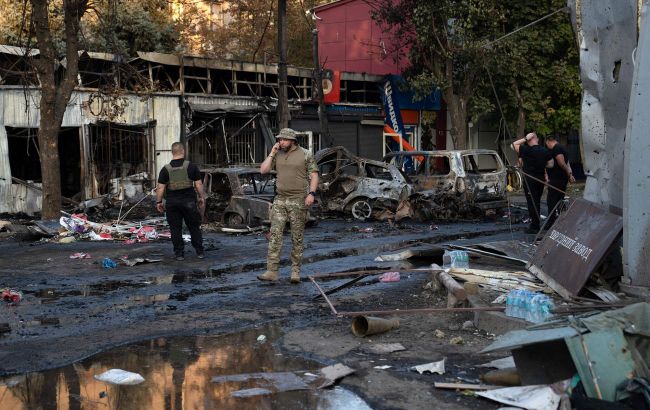Russians hit Kostiantynivka with S-300 system on 6 September - Ukrainian Security Service
 Russians hit Kostiantynivka with S-300 system on 6 September (Photo: Getty Images)
Russians hit Kostiantynivka with S-300 system on 6 September (Photo: Getty Images)
On September 6, Russian forces struck Kostyantynivka in the Donetsk region. The enemy used the S-300 missile system to shell the market, according to the press service of the Security Service of Ukraine (SSU).
According to the investigation, the occupiers targeted the market in Kostyantynivka with the S-300 missile system, and this is evidenced, among other things, by the identified missile fragments collected at the scene of the tragedy.
The investigation also examines other materials pointing to the enemy's involvement in this shelling.
The pre-trial investigation is ongoing, and expert examinations have been appointed to establish this war crime's circumstances.
The investigation is being conducted under Article 438 of the Criminal Code of Ukraine (violations of the laws and customs of war).
What did NYT write?
Today, The New York Times published an investigation suggesting that the strike on Kostyantynivka may have been a "tragic accident."
Journalists wrote that a Ukrainian air defense missile from a "Buk" system allegedly fell on the market.
The agency claims that evidence collected and analyzed by The New York Times, including missile fragments, satellite images, eyewitness accounts, and social media posts, supports this conclusion.
"It appears the attack was a tragic mishap. Anti-aircraft defense experts say such missiles can veer off course for various reasons, including electronics malfunctions or damaged or severed rings during launch," the article states.
Issues with the author of the article
Sources within RBC-Ukraine have pointed out that the author of this article, Thomas Gibbons-Neff, has been repeatedly observed promoting Russian narratives. He systematically produces anti-Ukrainian materials for The New York Times, attempting to discredit Ukraine and its army.
He previously claimed that the Ukrainian Armed Forces were "using cluster munitions in populated areas," asserted that Ukrainian troops "trade tanks and artillery," and accused American volunteers assisting Ukraine of wastefulness and misconduct.
RBC-Ukraine's sources provided only a few examples of his articles:
- "To Push Back Russians, Ukrainians Hit a Village With Cluster Munitions"
- "A Frontline Shadow Economy: Ukrainian Units Trade Tanks and Artillery"
- "Stolen Valor: The U.S. Volunteers in Ukraine Who Lie, Waste and Bicker"
Furthermore, this journalist has had his press credentials revoked twice by the Armed Forces of Ukraine for rules violations while working in conflict areas, according to a Security and Defense Forces spokesperson.
Reaction from the President's Office
Mykhailo Podolyak, an advisor to the President's Office, has already responded to The New York Times' publication. He noted that the appearance of publications in foreign media casting doubt on Russia's involvement in the strike on Kostyantynivka leads to the growth of conspiracy theories and will require additional legal assessment by law enforcement agencies.
"Society will receive an answer to the question of what exactly happened in Kostyantynivka, as in thousands of other cases of Russian strikes on our country within the framework of an unprovoked war," Podoliak wrote on social media.
Shelling of Kostyantynivka on September 6
On September 6, Russian occupiers shelled the city of Kostyantynivka in the Donetsk region. This incident targeted the local market, resulting in 16 fatalities and 33 injuries.

